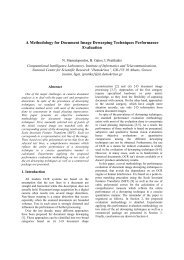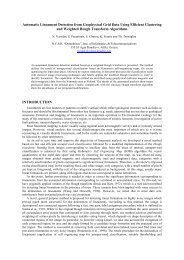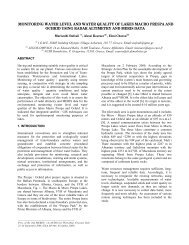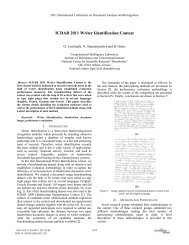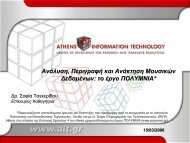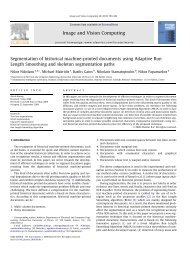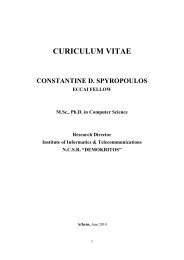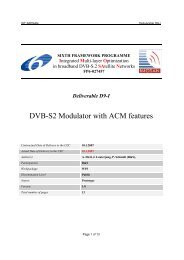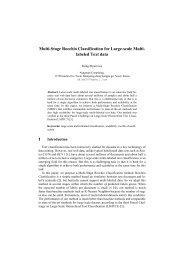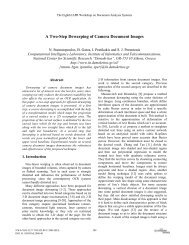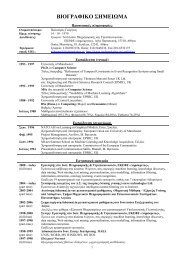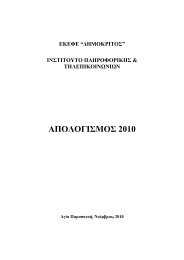TMS320C6713B Floating-Point Digital Signal Processor (Rev. A)
TMS320C6713B Floating-Point Digital Signal Processor (Rev. A)
TMS320C6713B Floating-Point Digital Signal Processor (Rev. A)
You also want an ePaper? Increase the reach of your titles
YUMPU automatically turns print PDFs into web optimized ePapers that Google loves.
SYNCHRONOUS DRAM TIMING<br />
timing requirements for synchronous DRAM cycles † (see Figure 40)<br />
SPRS294 − OCTOBER 2005<br />
NO.<br />
PYP-200,-225<br />
GDP/ZDP -225, -300<br />
PYPA -167, -200 UNIT<br />
GDPA/ZDPA −200<br />
MIN MAX<br />
6 tsu(EDV-EKOH) Setup time, read EDx valid before ECLKOUT high 1.5 ns<br />
7 th(EKOH-EDV) Hold time, read EDx valid after ECLKOUT high 2.5 ns<br />
† The C6713B SDRAM interface takes advantage of the internal burst counter in the SDRAM. Accesses default to incrementing 4-word bursts,<br />
but random bursts and decrementing bursts are done by interrupting bursts in progress. All burst types can sustain continuous data flow.<br />
switching characteristics over recommended operating conditions for synchronous DRAM<br />
cycles †‡ (see Figure 40−Figure 46)<br />
NO.<br />
PARAMETER<br />
PYP-200,-225<br />
GDP/ZDP -225, -300<br />
PYPA -167, -200<br />
GDPA/ZDPA −200<br />
UNIT<br />
MIN MAX<br />
1 td(EKOH-CEV) Delay time, ECLKOUT high to CEx valid 1.5 7 ns<br />
2 td(EKOH-BEV) Delay time, ECLKOUT high to BEx valid 7 ns<br />
3 td(EKOH-BEIV) Delay time, ECLKOUT high to BEx invalid 1.5 ns<br />
4 td(EKOH-EAV) Delay time, ECLKOUT high to EAx valid 7 ns<br />
5 td(EKOH-EAIV) Delay time, ECLKOUT high to EAx invalid 1.5 ns<br />
8 td(EKOH-CASV) Delay time, ECLKOUT high to ARE/SDCAS/SSADS valid 1.5 7 ns<br />
9 td(EKOH-EDV) Delay time, ECLKOUT high to EDx valid 7 ns<br />
10 td(EKOH-EDIV) Delay time, ECLKOUT high to EDx invalid 1.5 ns<br />
11 td(EKOH-WEV) Delay time, ECLKOUT high to AWE/SDWE/SSWE valid 1.5 7 ns<br />
12 td(EKOH-RAS) Delay time, ECLKOUT high to, AOE/SDRAS/SSOE valid 1.5 7 ns<br />
† The C6713B SDRAM interface takes advantage of the internal burst counter in the SDRAM. Accesses default to incrementing 4-word bursts,<br />
but random bursts and decrementing bursts are done by interrupting bursts in progress. All burst types can sustain continuous data flow.<br />
‡ ARE/SDCAS/SSADS, AWE/SDWE/SSWE, and AOE/SDRAS/SSOE operate as SDCAS, SDWE, and SDRAS, respectively, during SDRAM<br />
accesses.<br />
POST OFFICE BOX 1443 • HOUSTON, TEXAS 77251−1443<br />
113



